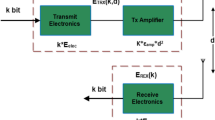Abstract
In this paper, we propose a new algorithm for efficient overlay construction for wireless sensor networks to minimize energy consumption thereby enhancing the network lifetime. In the proposed algorithm, sensor nodes are grouped into clusters of unequal size and the selection of cluster heads (CHs) depends on their residual energy. To route the data to the sink, a routing overlay (RO) of the CHs is constructed and this is done only once during the lifetime of the network. We devise an efficient data relaying strategy to balance the energy consumption of the CHs in the RO. The proposed algorithm also replaces a CH and reconfigures the RO by making decision locally. We perform extensive experiments through simulation run. The simulation results are compared with the existing algorithms which show that the proposed algorithm outperforms in terms of network lifetime, energy consumption and other performance metrics.









Similar content being viewed by others
References
Akyildiz, I. F., Su, W., Sankarasubramaniam, Y., & Cayirci, E. (2002). Wireless sensor networks: Survey. Computer Networks, 38, 393–422.
Abbasi, A. A., & Younis, M. (2007). A survey on clustering algorithms for wireless sensor networks. Computer Communication, 30, 2826–2841.
Heinzelman, W. B., Chandrakasan, A., & Balakrishnan, H. (2000). Energy-efficient communication protocols for wireless microsensor networks. In Proceedings of Hawaii international conference on system sciences.
Younis, O., & Fahmy, S. (2004). HEED: A hybrid, energy-efficient, distributed clustering approach for ad hoc sensor networks. IEEE Transaction on Mobile Computing, 3, 366–379.
Ding, P., Holliday, J., & Celik, A. (2005). Distributed energy-efficient hierarchical clustering for wireless sensor networks. LNCS, 20.
Ye, M., Li, C. F., Chen, G. H., & Wu, J. (2005). EECS: An energy efficient clustering scheme in wireless sensor networks. In IEEE international performance computing and communication conference (pp. 535–540).
Ye, M., Li, C. F., Chen, G. H., & Wu, J. (2005). An energy-efficient unequal clustering mechanism for wireless sensor networks. In Proceedings of the international conference on mobile ad hoc and sensor systems (p. 8).
Chan, H., & Perrig, A. (2004). ACE: An emergent algorithm for highly uniform cluster formation. In Proceedings of the first european workshop on sensor networks (pp. 154–171).
Ye, M., Li, C. F., Chen, G. H., & Wu, J. (2005). An energy-efficient unequal clustering mechanism for wireless sensor networks. In Proceedings of the international conference on mobile ad hoc and sensor systems ( p. 8).
Cao, Y., & He, C. (2006). A distributed clustering algorithm with an adaptive backoff strategy for wireless sensor networks. IEICE Transactions on Communications, 89, 609–613.
Dimokas, N., Katsaros, D., & Manolopoulos, Y. (2010). Energy-efficient distributed clustering in wireless sensor networks. Journal of Parallel and Distributed Computing, 70, 371–383.
Ali, C., & Samuel, P. (2012). A distributed energy-efficient clustering protocol for wireless sensor networks. Computers & Electrical Engineering, 36, 303–312.
Nauman, A., William, P., William, R., & Shyamala, S. (2011). A multi-criterion optimization technique for energy efficient cluster formation in wireless sensor networks. Information Fusion, 12, 202–212.
Amgoth, T., & Jana, P. K. (2013). BDCP: A backoff-based distributed clustering protocol for wireless sensor networks. In Proceedings of the international conference on advances in computing, communication and informatics (pp. 1012–1016).
Perillo, M., Cheng, Z., & Heinzelman, W. (2004). On the problem of unbalanced load distribution in wireless sensor networks. In Proceedings of the IEEE GLOBECOM workshops (pp. 74–79).
Muruganathan, S. D., Ma, D. C. F., Bhasin, R. I., & Fapojuwo, A. O. (2005). A centralized energy-efficient routing protocol for wireless sensor networks. IEEE Communication Magazine, 43, s8–s13.
Yu, M., Kin, K. L., & Ankit, M. (2007). A dynamic clustering and energy efficient routing techniques for sensor networks. IEEE Transaction on Wireless Communications, 6, 3069–3079.
Fariborzi, H., & Moghavvemi, M. (2009). EAMTR: Energy aware multi-tree routing for wireless sensor networks. IET Communication, 3, 733–739.
Gagarin, A., Hussain, S., & Yang, L. T. (2010). Distributed hierarchical search for balanced energy consumption routing spanning trees in wireless sensor networks. Journal of Parallel and Distributed Computing, 70, 975–982.
Ren, F., Zhang, J., He, T., Lin, C., & Das, S. K. (2011). EBRP: Energy-balanced routing protocol for data gathering in wireless sensor networks. IEEE Transactions on Parallel and Distributed Systems, 22, 2018–2125.
Abdel salam, H. S., & Olariu, S. (2012). BEES: Bioinspired backbone selection in wireless sensor networks. IEEE Transactions on Parallel and Distributed Systems, 23, 44–51.
Liu, Y., & Wang, Z. (2012). Maximizing energy utilization routing scheme in wireless sensor networks based on minimum hops algorithm. Computers & Electrical Engineering, 38, 703–721.
Jiguo, Y., Yingying, Q., Guangui, W., & Xin, G. (2012). A cluster-based routing protocol for wireless sensor with non-uniform node distribution. International Journal of Electronics and Communications, 66, 54–61.
Abdulla, A. E. A. A., Nishiyama, H., & Kato, N. (2012). Extending the lifetime of the wireless sensor networks: A hybrid routing algorithm. Computer Communications, 35, 1056–1063.
Niculescu, D., & Nath, B. (2001). Ad hoc positioning system. In Proceedings of the global telecommunications conference (pp. 2926–2931).
Author information
Authors and Affiliations
Corresponding author
Rights and permissions
About this article
Cite this article
Amgoth, T., Jana, P.K. Efficient Overlay Construction for Wireless Sensor Networks. Wireless Pers Commun 86, 959–973 (2016). https://doi.org/10.1007/s11277-015-2964-3
Published:
Issue Date:
DOI: https://doi.org/10.1007/s11277-015-2964-3




